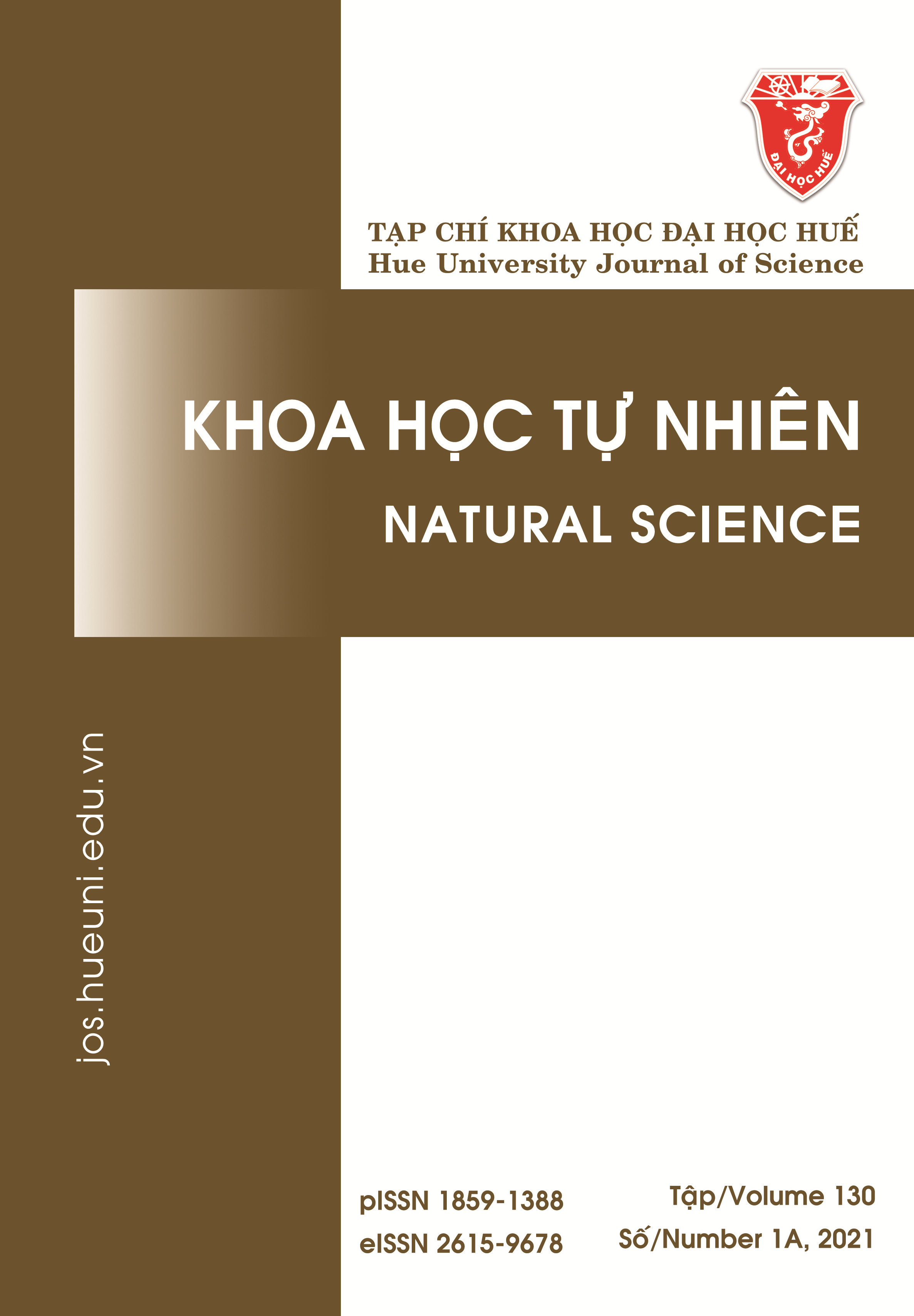Abstract
The authors isolated 39 fungal species from soil planting citrus trees. Seven fungi have high antagonistic efficacy against Fusarium solani, and eight fungi are effective in inhibiting the growth of Rhizoctonia solani. These fungi have antagonistic efficacy values of more than 60% on the 7th day after applying fungal slices. Among the effective isolates, Penicillium citrinum – a kind of Mycorrhizae – has an antagonistic efficacy of 60.63% toward F. solani and 73.13% toward R. solani.
References
- Thuận HN. Kỹ thuật chọn tạo và trồng cây cam quýt. Hà Nội (VN): Nxb Nông nghiệp; 2004. 230 p.
- Hưng ND. Nghiên cứu tuyển chọn và phát triển giống cam, quýt không hạt ở phía Bắc. Hà Nội (VN): Nxb Nông nghiệp; 2015.
- Mão TV. Sử dụng vi sinh vật có ích, Tập 2. Ứng dụng nấm cộng sinh và vi sinh vật phòng trừ sâu hại. Hà Nội (VN): Nxb Nông nghiệp; 2004. 197 p.
- Khade SW. Mycorrhizal association in different varieties of banana (Musa sp.) in soils of Goa [master's thesis]. Goa (India): Goa University; 1999.
- Soares ACF, Martins MA, Mathias L, Freitas MSM. Arbuscular mycorrhizal fungi and the occurrence of flavonoids in roots of passion fruit seedlings. Scientia Agricola. 2005;62(4):331-336. DOI: https://doi.org/10.1590/S0103-90162005000400005
- Singh RP, Prasad V. Occurrence and population dynamics of vesicular arbuscular mycorrhizae in the Indian orchards of litchi Litchi chinensis Sonn., aonla Phyllanthus emblica L. and banana Musa paradisiaca L. Asian Journal of Bio Science. 2006;1(2):154-156.
- Schreiner RP. Mycorrhizas and Mineral Acquisition in Grapevines. In: Christensen LP, Smart DR, editors. Proceedings of the soil environment and vine mineral nutrition symposium. San Diego, CA (USA); American Society for Enology and Viticulture; 2005. pp. 49-60.
- Schreiner RP. Effects of native and non native arbuscular mycorrhizal fungi on growth and nutrient uptake of ‘Pinot noir’ (Vitis vinifera L.) in two soils with contrasting levels of phosphorus. Applied Soil Ecology. 2007;36(2-3):205-215. DOI: https://doi.org/10.1016/j.apsoil.2007.03.002
- Sumorok B, Sas-Paszt L, Głuszek S, Derkowska E, Żurawicz E. The effect of mycorrhisation and mulching of apple trees ‘Gold Millennium’ and blackcurrant bushes ‘Tiben’ on the occurrence of arbuscular mycorrhizal fungi. Journal of Fruit and Ornamental Plant Research. 2011;19(1):35-49.
- Sarwade PP, Chandanshive SS, Kanade MB, Bhale UN. Diversity of Arbuscular mycorrhizal (AM) fungi in some common plants of Marathwada region. International Multidisciplinary Research Journal. 2011;1(12):11-12.
- Sukhada M. Arbuscular mycorrhizal fungi benefit mango (Mangifera indica L.) plant growth in the field. Scientia Horticulturae. 2012;143:43-48. DOI: https://doi.org/10.1016/j.scienta.2012.05.030
- Kumar V, Wingfield JC, Dawson A, Ramenofsky M, Rani S, Bartell P. Biological clocks and regulation of seasonal reproduction and migration in birds. Physiological and Biochemical Zoology. 2010;83(5):827-835. DOI: https://doi.org/10.1086/652243
- Choi YW, Hyde KD, Ho WH. Single spore isolation of fungi. Fungal Diversity. 1999;3: 29-38.
- Atlas RM. Handbook of Microbiological Media, 4th ed. New York (USA): CRC Press; 2010; p. 771-779.
- Abdel-Fattah GM, El-Haddad SA, Hafez EE, Rashad YM. Induction of defense responses in common bean plants by arbuscular mycorrhizal fungi. Microbiological Research. 2011;166(4):268-281. DOI: https://doi.org/10.1016/j.micres.2010.04.004
- Khan S, Hamayun M, Yoon H, Kim H, Suh S, Hwang S, et al. Plant growth promotion and Penicillium citrinum. BMC Microbiology. 2008;8(1):231. DOI: https://doi.org/10.1186/1471-2180-8-231
- Curtis RF, Hassall CH, Nazar M. The biosynthesis of phenols. Part XV. Some metabolites of Penicillium citrinum related to citrinin. Journal of the Chemical Society C: Organic. 1968;1:85-93. DOI: https://doi.org/10.1039/j39680000085
- Lan PTN, Châu NTB, Chi NQ. Phân lập và tuyển chọn chủng nấm mốc có khả năng phân giải pectin. Hội nghị khoa học toàn quốc về Sinh thái và Tài nguyên sinh vật lần thứ 7; 2017; Hà Nội. Hà Nội: Nxb Khoa học tự nhiên và Công nghệ; 2017. p. 1304-1310.
- Endo A, Kuroda M, Tsujita Y. ML-236A, ML-236B, and ML-236C, new inhibitors of cholesterogensis produced by Penicillium citrinum. The Journal of Antibiotics. 1976;29(12): 1346-1348. DOI: https://doi.org/10.7164/antibiotics.29.1346

This work is licensed under a Creative Commons Attribution-ShareAlike 4.0 International License.
Copyright (c) 2021 Array




